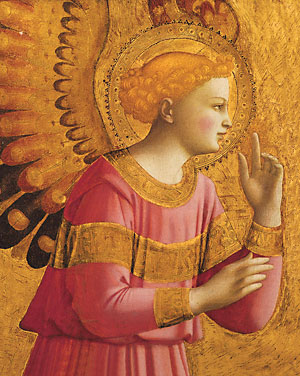 |
| Detail of the painting by Blessed Fra Angelico of the Archangel Gabriel. |
“Fortitudo Dei”, one of the three archangels mentioned in the Bible. Only four appearances of Gabriel are recorded:
- In Dan., viii, he explains the vision of the horned ram as
portending the destruction of the Persian Empire by the Macedonian
Alexander the Great, after whose death the kingdom will be divided up
among his generals, from one of whom will spring Antiochus Epiphanes.
- In chapter ix, after Daniel had prayed for Israel, we read that “the
man Gabriel . . . . flying swiftly touched me” and he communicated to
him the mysterious prophecy of the “seventy weeks” of years which should
elapse before the coming of Christ. In chapter x, it is not clear
whether the angel is Gabriel or not, but at any rate we may apply to him
the marvelous description in verses 5 and 6.
- In the New Testament he foretells to Zachary the birth of the Precursor, and
- to Mary that of the Savior.
Thus he is throughout the angel of the Incarnation and of
Consolation, and so in Christian tradition Gabriel is ever the angel of
mercy while Michael is rather the angel of judgment. At the same time,
even in the Bible, Gabriel is, in accordance with his name, the angel of
the Power of God, and it is worthwhile noting the frequency with which
such words as “great”, “might”, “power”, and “strength” occur in the
passages referred to above. The Jews indeed seem to have dwelt
particularly upon this feature in Gabriel’s character, and he is
regarded by them as the angel of judgment, while Michael is called the
angel of mercy. Thus they attribute to Gabriel the destruction of Sodom
and of the host of Sennacherib, though they also regard him as the angel
who buried Moses, and as the man deputed to mark the figure Tau on the
foreheads of the elect (Ezech., 4). In later Jewish literature the names
of angels were considered to have a peculiar efficacy, and the British
Museum possesses some magic bowls inscribed with Hebrew, Aramaic, and
Syriac incantations in which the names of Michael, Raphael, and Gabriel
occur. These bowls were found at Hillah, the site of Babylon, and
constitute an interesting relic of the Jewish captivity. In apocryphal
Christian literature the same names occur, cf. Enoch, ix, and the
Apocalypse of the Blessed Virgin.
As remarked above, Gabriel is mentioned only twice in the New
Testament, but it is not unreasonable to suppose with Christian
tradition that it is he who appeared to St. Joseph and to the shepherds,
and also that it was he who “strengthened” Our Lord in the garden (cf.
the Hymn for Lauds on 24 March). Gabriel is generally termed only an
archangel, but the expression used by St. Raphael, “I am the angel
Raphael, one of the seven, who stand before the Lord” (Tob., xii, 15)
and St. Gabriel’s own words, “I am Gabriel, who stand before God” (Luke
1, 19), have led some to think that these angels must belong to the
highest rank; but this is generally explained as referring to their rank
as the highest of God’s messengers, and not as placing them among the
Seraphim and Cherubim (cf. St. Thomas, I, Q. cxii, a.3; III, Q. xxx,
a.2, ad 4um).


No comments:
Post a Comment